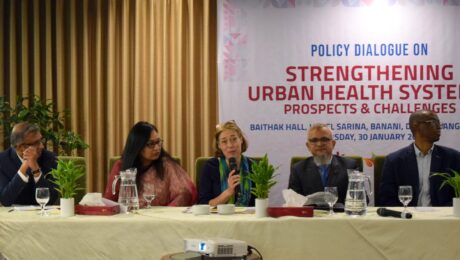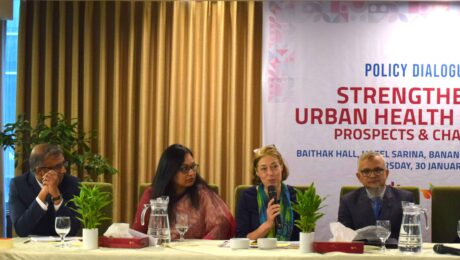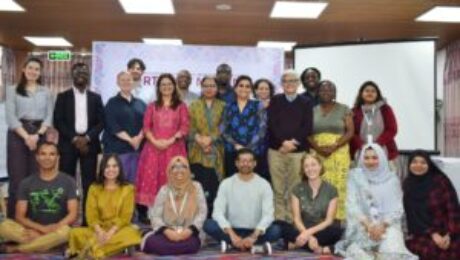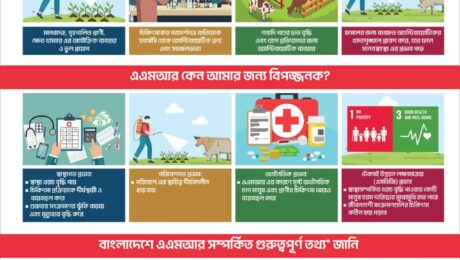Health policymakers, researchers, and development partners gathered in Dhaka to discuss challenges and prospects for urban health in low- and middle-income countries (LMICs). The policy dialogue, titled Strengthening Urban Health Systems: Prospects & Challenges, was organized by ARK Foundation Bangladesh and BRAC James P. Grant School of Public Health on Thursday (30 January 2025).
- Published in News, News and Media
No Comments
The Community-led Responsive and Effective Urban Health System (CHORUS) is a Research Programme Consortium that brings together health researchers from Africa, South Asia, and the UK. CHORUS collaborates with communities, health professionals, and city-level decision makers to develop and test strategies for improving the health of the poorest urban residents. As part of its
- Published in Event, News and Media
The CHORUS Partners Meeting, hosted by ARK, took place from January 26th to 29th at Hotel Lake Castle in Dhaka, bringing together researchers, policymakers, and experts from Bangladesh, Nepal, Ghana, Nigeria, and the UK. The event focused on sharing insights and strategies for strengthening urban health systems across the participating countries. Discussions explored early findings,
- Published in Event, News and Media
Abdullah M. Rafi Read the PDF Version Mr. Mahmud (pseudonym), 59, the Tuberculosis & Leprosy Controller Assistant (TLCA) at one of the TB centers on the outskirts – a 70-kilometer drive from the capital Dhaka – reflecting on his journey in combating TB, asserted that if people stopped using tobacco products, the number of TB
- Published in Blog, Featured, News and Media
To raise awareness about the dangers of #antimicrobialresistance (AMR) among local communities in Dhaka, Bangladesh, artists and researchers have joined forces, using street plays as a powerful medium to convey their message. This innovative collaboration marks one of the first initiatives where artists actively engage with communities to address the growing threat of AMR
- Published in News and Media, Video
Engaging rural communities in Bangladesh to tackle AMR through the Community Dialogue Approach (CDA)
We’re excited to share our latest publication in Frontiers! Led by Md Badruddin Saify as the corresponding author, alongside co-authors Prof. Rumana Huque, Samina Huque, Sajib Saha, and their dedicated team, this study, titled: “Engaging rural communities in Bangladesh to tackle antimicrobial resistance through the Community Dialogue Approach (CDA): A process evaluation protocol for COSTAR
- Published in Journal Article, Resources
On the occasion of the 11th anniversary of the ARK Foundation, a roundtable discussion titled “Universal Healthcare in Bangladesh: Challenges and Opportunities” was organized by the ARK Foundation and Prothom Alo on 30 November 2024. To read the summary of the speakers’ speeches, please go to this link or find the PDF here আর্ক ফাউন্ডেশনের ১১
- Published in Event, Featured, News, News and Media
PDF Version On the occasion of its 11th anniversary, ARK Foundation organized a roundtable discussion titled ‘Universal Healthcare in Bangladesh: Challenges and Opportunities’ in support of one of the most prominent dailies of the country, Prothom Alo. To read the summary of the speeches, please go to this link
- Published in News, News and Media
World Antimicrobial Awareness Week (WAAW) 2024 (Nov 18-24) begins today, reinforcing the message to “Educate. Advocate. Act now.” in tackling the AMR crisis.This year’s theme calls on everyone- from policymakers to the general public- to learn about the growing threat of antimicrobial resistance (AMR) and take urgent steps to combat it. ARK, has been actively
- Published in Infographics, Resources
On November 11, 2024, ARK Foundation researchers conducted a workshop titled ‘Patient and Public Participation in Tobacco Cessation and Tuberculosis Prevention’ at Shaheed Ahsanullah Master General Hospital in Tongi, Dhaka. This Community Engagement Program, based on RESPIRE’s Quit4TB Trial, aimed to connect tobacco cessation efforts with tuberculosis prevention. The event brought together notable attendees, including
- Published in Event, News and Media










